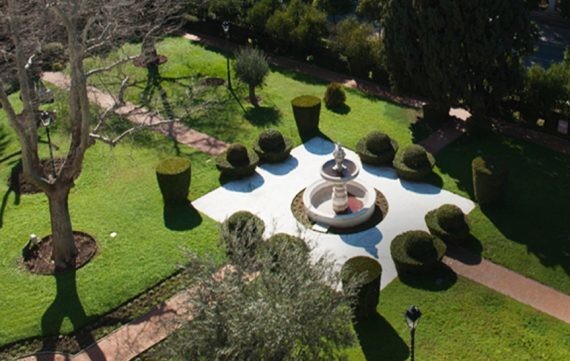GARDEN
an oasis of green in downtown Athens
THE GARDEN
OF THE MANSION
The garden of the Presidential Mansion occupies an area of about 25.000 square meters and forms an oasis of green in the heart of Athens. In fact, because of its particularly fertile soil, for most of the nineteenth century the area served as the vegetable garden of the Royal Palace, now housing the Greek Parliament.
After the erection of the mansion in 1897 and the construction of Herodou Attikou Street, the area surrounding the Crown Prince’s Palace was shaped into a large ornamental garden. The planning appears to have been assigned to Ziller’s office, however the selection of vegetation was most likely entrusted to a Greek specialist, since most of the plants and trees are native to Greece.
From the very beginning the garden was divided into two large sections, adapted to the existing slope of the land. The building of the Mansion is situated in the upper section.
The design of the garden in front of the building is similar to that of other neo-classical structures of the same period, including the Academy, the University and the National Library. The garden has a strict geometric form, in French style, with symmetrical beds of grass and seasonal flowering plants. The formalism of the composition towards Herodou Attikou Street is complemented by perennial plane trees such as lindens, palms and cypresses.
A wide marble staircase leads to the lower level, which contains the larger section of the garden. Symmetry is preserved there. A long path flanked by high cypresses leads to a pond and a pavilion, and serves as the focal point of the composition. On both sides of the path there are grass lawns, stepped terraces, flower beds and areas with trees and bushes. High trees have been planted next to the railings around the entire garden.
The botanic composition of the garden is quite rich, and includes about one hundred and forty species and varieties of ornamental trees, bushes, climbing plants and other types of vegetation. Some of these plants are rare, and many of the trees in the garden, such as the cypresses, count more than a hundred years of age.
From its initial design at the end of the nineteenth century up until the early 1970’s the palace garden was preserved without significant change. Since 1974 the garden has undergone several changes. The most important of these is the addition of a wide marble staircase, which facilitates access to the lower part of the garden.


